
9. X-Pigeons |
||||
~ Pigeon's Eye & Colors ~
Pigeon vision:
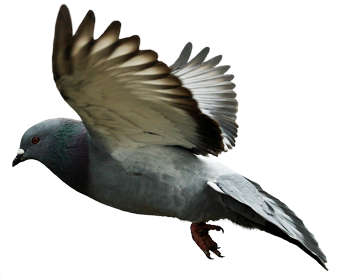 Darwin,
in the Origin of Species (1859), called eyes "organs
of extreme perfection." It is undeniable that pigeons have far
better eyesight and optical mechanisms superior to that of man. The
pigeon's eye is one-half the weight of its brain, whereas man's eye
is only one-fiftieth of his brain weight. Pigeons have a very wide
visual field of around 340° compared to the 180°of humans.
Given the high general cone density of birds, in principle a pigeon
can track an externally moving object without moving its head or
eyes over much greater displacements than a human can. To remain
alive in the wild, a pigeon needs to keep its eyes open for predators.
Having eyes on the side of its head gives a pigeon a wide field of
view, and in order to fly at speed, a pigeon's brain can process
visual information three times faster than a human's brain can.
Darwin,
in the Origin of Species (1859), called eyes "organs
of extreme perfection." It is undeniable that pigeons have far
better eyesight and optical mechanisms superior to that of man. The
pigeon's eye is one-half the weight of its brain, whereas man's eye
is only one-fiftieth of his brain weight. Pigeons have a very wide
visual field of around 340° compared to the 180°of humans.
Given the high general cone density of birds, in principle a pigeon
can track an externally moving object without moving its head or
eyes over much greater displacements than a human can. To remain
alive in the wild, a pigeon needs to keep its eyes open for predators.
Having eyes on the side of its head gives a pigeon a wide field of
view, and in order to fly at speed, a pigeon's brain can process
visual information three times faster than a human's brain can.
Despite the sophisticated visual abilities that non-mammalian amniotes (reptiles and birds) and primates share, there are some differences between mammals' and birds' eyes, and some of these may have implications for movement perception and a very different view of the world. Because birds generally have flatter eyeballs than mammals, they have severe limitations on swiveling their eyeballs, so they rely on head movements. Pigeons are among the birds with a dual fovea and the two visual systems, frontal and lateral, and they both have different properties. Consequently, unless there are mechanisms to compensate for the changes in the stimulation, an object that moves between frontal and lateral systems could pose problems for the bird's perception.
Therefore, we can argue that nature is full of compromises and imperfections, and evolution is a continuous process. According to Richard Dawkins, an evolutionary biologist, the basic chemistry that makes up the light-sensitive cells of the eyes is shared right across the animal kingdom, and science has uncovered species at every stage in the evolution of the eye. It is a cumulative process, and each step of the way is more useful and consequently more beneficial than the one before. The eye has evolved independently at least 40 different times around the animal kingdom and it has evolved gradually, improvement on improvement, and yet in the eyes of evolutionary biology, no organs will ever be considered as perfect - it has a lot of vulnerabilities built-in which can be explained only by how natural selection works.
Even though pigeons
can see color in the same way that humans do, pigeons can also see
ultra-violet light - a part of the spectrum
that humans
cannot see. Their eyes can detect ultraviolet radiation from the
sun, even on cloudy days, and this ability is essential for
their navigation.
Birds have proportionally more light receptors in their retina than
mammals, and more nerve connections between the photoreceptors
and the brain.
Most birds are tetrachromatic, possessing ultraviolet (UV) sensitive
cone cells in the eye as well as those for red, green and blue, but
pigeons have an additional pigment and they are therefore pentachromatic
- condition
of possessing five independent channels for conveying color information.
By comparison, combinations of red, green, and blue lights are all
that is necessary to simulate most of the average human's visual
spectrum. Pigeons are trained by United States Coast Guard
for seek and rescue
operations. Their ability to see ultra violet lights proved them
to be
92 percent accurate, compared to 30-40 percent human ability to spot
red or yellow jackets in the water. Pigeons also have sensitivity
to polarized
lights and they can see an aspect of light that is invisible to humans.
Pigeons are able see stars during bright day light but their vision
goes down at dark and they can't see as well as the humans in dark.
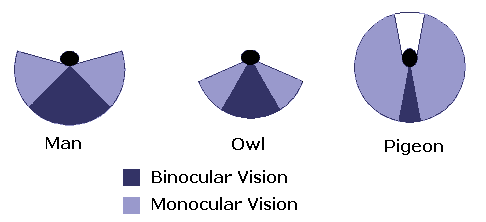
Have you ever wonder, why pigeons fly out of the way of on oncoming car at the last second? According to David Gains - British Garden Birds, most birds have binocular vision, like ours, so that they can precisely judge distances. Raptors, such as hawks and owls, have especially well developed binocular vision and their eyes are towards the front of the head - owls' eyes are forward facing. Small birds usually have their eyes more to the side of the head so that they have better all-round vision and can see danger in all directions. Birds such as pigeons and waterfowl, whose eyes are side facing, have so little binocular vision that rely on apparent motion between close and distant objects to judge distance. That is, imagine that you are travelling along in a car or train, the scenery closest to you seems to pass in a blur while the scenery on the horizon appears almost motionless.
Pigeons' eyes are located on the sides of their heads and are adapted to show them a huge swath of the visual scene - they can see an area of 340° without moving their heads. The disadvantage of this remarkable 'surround vision' is that movements produce significant motion parallax errors - where objects nearby appear to move faster than objects further away - which can be very confusing. Thus, it can be the biggest disadvantage of pigeons against predators that use element of surprise to catch their pray, such as Hawks. Most pigeons are prayed by hawks when they are sitting ducks. A hawk has little to no chance to catch a pigeon in air, because pigeons can fly much faster than hawks can. However, hawks are expert hunters to surprise their pray when their pray is about to land or has already landed.
Anatomy of Eyes:
Without getting too technical,
let’s talk about main parts of the eye.
The main purpose of the eye is to capture light and project images to
the brain for processing. The detection of the light, color, and image
processing is done by the retina; for practical purposes, you can think
the retina as an extension of the brain where most of the data is collected,
processed, compressed, and sent to the brain. The retina is the nerve
layer that lines the back of the eye, directly on the other end of the
pupil and creates impulses that travel through the optic nerve to the
brain. 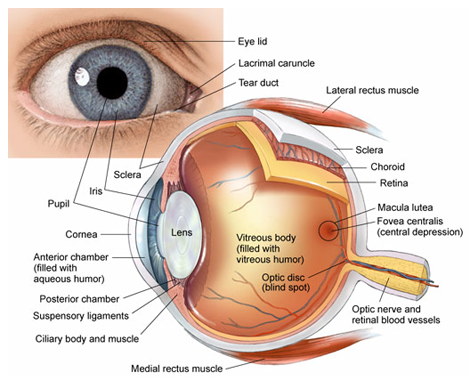
The pupil is a transparent opening located in the center of the iris of the eye that allows light to enter the retina. It appears dark because most of the light entering the pupil is absorbed by the tissues inside the eye, which has black pigment cells. The reason the pupil is very dark is to stop internal reflections that could destroy or distort the image on the retina. This black surface serves the same purpose as painting the inside of a camera black. The image of the pupil as seen from outside the eye is the entrance of the pupil, which does not exactly correspond to the location and size of the physical pupil because it is magnified by the cornea.
The cornea is the transparent front part of the eye that covers the iris, pupil, and anterior chamber, while transmitting and focusing light into the eye. While the cornea consists of approximately two-thirds of the eye's focusing power, its focus is fixed. The cornea has nerve endings that are sensitive to touch, temperature and chemicals; a touch of the cornea causes an involuntary reflex to close the eyelid. Because transparency is of prime importance to focus, the cornea does not have blood vessels. Nutrients for the cornea are supplied by the same source as the tear ducts and internal vitreous fluids. The cornea is often compared to the outer lens of a camera, but its focusing is fixed is. The curvature of the lens, on the other hand, can be adjusted to "tune" the focus depending upon the object's distance.
The crystalline lens is a transparent, biconvex structure in the eye that, along with the cornea, helps to refract light to be focused on the retina. The lens, by changing shape, functions to change the focal distance of the eye so that it can focus on objects at various distances, thus allowing a sharp, real image of the object of interest to be formed on the retina. This adjustment of the lens is known as accommodation. It is similar to the focusing of a photographic camera via movement of its lenses. The lens is flatter on its anterior side and is part of the anterior segment of the eye. Anterior to the lens is the iris, which regulates the amount of light entering into the eye.
The iris is a thin, circular structure in the eye, responsible for controlling the diameter and size of the pupils, and thus the amount of light reaching the retina. In response to the amount of light entering the eye, muscles attached to the iris expand or contract the aperture at the center of the iris, known as the pupil. When the pupil is larger, more light can enter. "Eye color" is the color of the iris. The iris in pigeons ranges from pink to greenish or bluish (rare) to orange to whitish; any of these can have various amounts of blood vessels, which are the tiny red lines. .
Pigeon Eye Colors:
According to W. F. Hollander, pigeons are able to produce at least 2 pigments in their eyes: Orange, white (pearl). Recall, when we refer to the eye color, the terminology we should use is “pigment” and not the “color” because there can be numerous versions of the same color produced by the same pigment. The orange and the pearl eye pigments appear on the outer iris of the eye. The orange pigmented eye is our wild-type, standard. The eye color gene is autosomal and therefore each pigeon carries two alleles and pearl eye is recessive to wild-type. Therefore, the eye color gene is not sex-linked, and we cannot determine the sex of the offspring by looking at their eye color. According to Dr. Richard Cryberg, the orange colored pigment is called pteridine where the “p’ on pteridine is silent. The white colored pigment found in the iris of the pigeons is called guanidines and they are whitish platelet like pigments. They are very common in fish and give fish the silvery, shiny look. These pigments are quite opaque and stop light from getting thru the iris. There are a variety of pigments found in the eyes of different species of animals. Black and brown melanin pigments are quite common; these are the main pigments found in human irises. It is hard to explain the greens and blues and even hints of black seen in some pigeon irises if there is no melanin.
Orange & White Eyes:
The orange pigment is also referred as yellow and could also be appear as red depending on the blood vessels found in the iris of the eyes. The white eye on the other hand can appear as pearl fish eye or fiery red pearl colors based on the amount of blood vessels found in the iris. There are no such pigments as red in the eyes of pigeons. Redness of the eye comes from the amount of blood vessels located on the surface of the iris and may give the appearance of red color. Because the amount of blood vessels found in the eyes varies, some eyes are much lighter and brighter than others and some have far greater amounts of red color in the iris. Sometimes this red is so spread that the orange or white pigments of the iris can barely be seen. We see variation of colors from fishy white eyes to yellow and bloody red colors because of the amount of blood vessels in the outer iris. In reality, there are only two eye pigments: Orange (wild-type) and white (pearl). In pearl eyes, the step to manufacture the pteridine in the iris of the eye is mutated, but the guanidine is manufactured normally. Therefore, the pearl eye is the result of lack of pteridine pigments manufactured at the surface level of the eye (iris). Because the quanidine is more or less white and it is opaque, the inner surface of the eye, where the black pigment is manufactured and located cannot be seen. When the pigment production is stopped completely at the surface level, and no pteridine or guanidine is manufactured, then we can see the black pigment in the inner surface of the iris and this is how we get the bull eyes.
Here are the examples of Orange eyes: All the red you see in these pictures are the blood vessels. Notice the Iris is yellow.
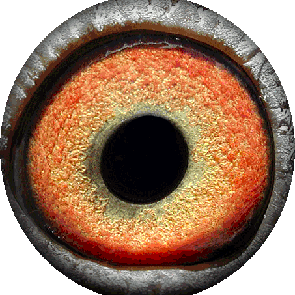
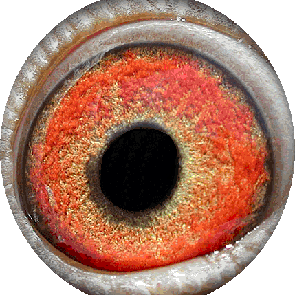
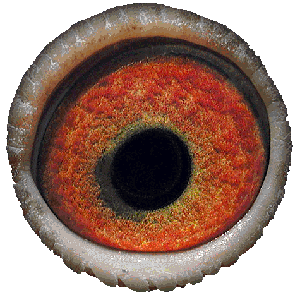
Here are the examples of Pearl eyes: All the red you see in these pictures are the blood vessels. Notice the Iris is white.
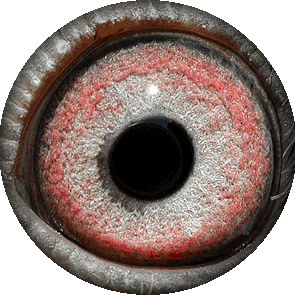
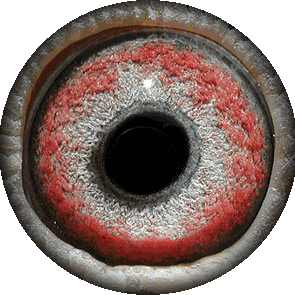
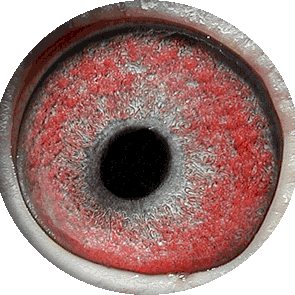
To determine if the eye is orange or white is very simple. Just look at the surface color (iris) right outside the pupil (the black center circle). The color right outside the pupil does not have blood vessels and appears as either pearl (white) or orange (yellow). If you look closely, you can see that the blood vessels are actually on top of the iris and sometimes cover the entire iris making it look like a red eye. The genetic symbol for orange eye is + since it is wild-type. The genetic symbol for the pearl eye is tr.
According to W. F. Hollander, the orange eye is the iris color of the Columba livia (wild-type) and most of the feral pigeons have this color. Pearl, on the other hand, is strictly found in domestic types. Some breeds, like Tumblers, Cumulets, and Nuns, never have orange eyes unless they were crossed with other breeds. All of my Turkish Tumblers (except recessive whites) have pearl eyes, which is the result of years of carefully breeding and selecting for this trait.
Bull Eyes:
Before we get into bull eyes, let’s understand the piebald mutation which is any patchwork mixture of white and colored plumage including baldhead, badge, beard mark, saddle, magpie, bell neck, ring neck, pencil, gazzi, white flights, white tails, etc., all showing a distinct piebald condition. The white and colored areas differs in the various breeds. These phenotypes are suspected to be combinations of pied factors - two or more mutations. Piebald is generally considered a solid white patch surrounded by color or a solid-colored patch surrounded by white. However, piebalds should not be confused with things like grizzle or most scattered white feathers on an almond pied.
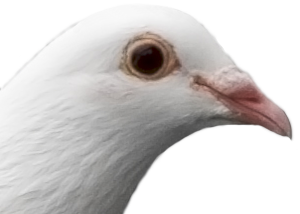 According to Dr.
Cryberg, pied is caused by lack of pigment cells at the white locations.
Pigment cells are modified nerve cells. In the embryo these nerve cells
develop in the neural crest. Some migrate over the surface of the body
just under the skin layer and produce pigments for feathers, beak,
toe nails, legs, skin and also make the orange and opaque white pigments
in the iris. Some of the pigment cells migrate within the
body and end up in the brain, intestine, inner parts of the eye and
sometimes
bones. A defect can prevent the external migration and when this happens
pigeons get white feathers anyplace the cells did not migrate to. Also
if they do not get to the outer iris of the eye, pigeons get no
pteridine (orange) or guanidine (white) pigments. Such mutations are
one of
the main causes
of pied birds and animals. Internal migration typically happens fine
even if external migration fails 100%. So, in pigeons we still get
pigment cells that migrate to the inner parts of the eye and those
pigment cells
make black pigment just fine. The net result is most pigeons with a
pied white head have bull eyes as the only pigment in the eye is the
black
pigment on the inside of the eye. As the normal pteridine and guanidine
pigments are absent from the iris, the iris is nearly transparent so
we
see thru it to the black pigment inside the eye.
According to Dr.
Cryberg, pied is caused by lack of pigment cells at the white locations.
Pigment cells are modified nerve cells. In the embryo these nerve cells
develop in the neural crest. Some migrate over the surface of the body
just under the skin layer and produce pigments for feathers, beak,
toe nails, legs, skin and also make the orange and opaque white pigments
in the iris. Some of the pigment cells migrate within the
body and end up in the brain, intestine, inner parts of the eye and
sometimes
bones. A defect can prevent the external migration and when this happens
pigeons get white feathers anyplace the cells did not migrate to. Also
if they do not get to the outer iris of the eye, pigeons get no
pteridine (orange) or guanidine (white) pigments. Such mutations are
one of
the main causes
of pied birds and animals. Internal migration typically happens fine
even if external migration fails 100%. So, in pigeons we still get
pigment cells that migrate to the inner parts of the eye and those
pigment cells
make black pigment just fine. The net result is most pigeons with a
pied white head have bull eyes as the only pigment in the eye is the
black
pigment on the inside of the eye. As the normal pteridine and guanidine
pigments are absent from the iris, the iris is nearly transparent so
we
see thru it to the black pigment inside the eye.
Bull eyed birds are simply birds which have the normal black pupil like all pigeons have, but their iris color is also look black even though when look closely we can see the pupil and the iris. It is imperative to understand that pigeons with bull eyes still carry two additional eye color genes in their genotype that we can't see by looking at their phenotype. Therefore, we can say that bull eye is epistatic to wild-type (orange) and pearl (white) eyes. The reason we can’t see one of the two possible eye pigments in bull eyed pigeons is not because of the lack of pigment, rather the presence of pigment without color, melanin. The bull eye is generally seen in recessive white and piebald whites. The name "bull eye" comes from its similarity in appearance to the dark eyes of cattle.
White feathers in most piebalds results from lack of melonocyte migration into the white area. A normal pigeon eye is not bull, although there are some curious exceptions like in ice pigeons. However, normally pigeon's eyes are either orange (wild-type) or pearl color, and these colors has no obvious relationship to the color of the feathers in a colored bird. In a bull eyed bird however, it is obvious that the orange pigment or the white pigment is not produced on the surface level (iris) so we can see the black pigment on the inside of the iris. All recessive white pigeons have bull eyes, white feathers, white beak, white skin and white nails. It's because just like the eye, rest of the phenotype genes for feather, beak, skin, and nail melanin production is turned off at the surface level. It seems because the melanin production in bull eyes are turned off genetically, and this allows light to pass into the eye and reflect the darker pigment of the iris's inner surface's. This makes the eye color appear to be dark brown. According to Dr. Cryberg, the external pigment cell migration of pigment cells to the iris of the eye and under the skin is closely linked in terms of the chemicals needed to guide the migration. But the chemical needs are not identical.
Pink Eyes:
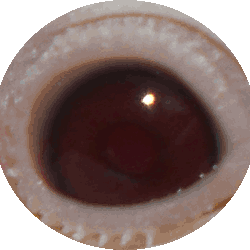 There
is also a pink looking eye found in albino pigeons. Albinism is a
mutation that eliminates pigment production all together. In the
case of bull
eyes, pigments are produced without the melanin where as in albino,
the pigments are not present at all. Without the pigments, what
we see is the reflection of the light through
the
blood
tissue
which looks like a pink color. Albinism also affects the skin, nail
and feather pigments of the pigeon and turns the feathers and skin
into white color, and beak and nail into ivory color.
There
is also a pink looking eye found in albino pigeons. Albinism is a
mutation that eliminates pigment production all together. In the
case of bull
eyes, pigments are produced without the melanin where as in albino,
the pigments are not present at all. Without the pigments, what
we see is the reflection of the light through
the
blood
tissue
which looks like a pink color. Albinism also affects the skin, nail
and feather pigments of the pigeon and turns the feathers and skin
into white color, and beak and nail into ivory color.
Albinism is a recessive trait and it only presents itself in homozygous state. Albinism could be carried by number of generations (in heterozygous state) and may never present itself. When two normal looking pigeons both carrying albinism are mated, they can produce albino offspring if they both donate the albino gene. Both parents must be either carrying the albino gene (heterozygous for albino) or both have to be albino (homozygous for albino) to be able to produce albino offspring. An albino eye is going to show on an otherwise bull eyed, orange or white eye pigeons, so we can clearly say that pink eye produced by albino mutation is epistatic to all eye colors.
"As albino is simply a mutation of the gene that codes for the enzyme tyrosinase it seems clear that tyrosinase must be important in production of both guanidines and pteridines. This again would confirm that these pigment cells are quite close to the cells that pigment feathers. When guanidine production is shut down in an albino the iris is no longer opaque. Some light is able to go right thru the iris to the inner eye. This is likely a lot of the reason for poor vision in albinos. Due to light entering the eye around the pupil it is not focused by the lens and there is a very poor image formed on the retina. An albino of course is also unable to make the black pigment in the inner front surface of the eyeball." Dr. Richard Cryberg.
Odd Eyes:
I often see this condition in my Birmingham Rollers, where one eye is either orange or pearl, but the other one is a bull eye. Since Rollers are loaded with pied mutations, odd eyes are very common in Rollers. Odd eyes sometimes referred as split eyes (partly colored or part bull) or eyes which are mismatched. One side colored and the other dark bull are always the result of no melanin production in the eye or in the dark areas of the eye. It is a mystery what causes odd eyes even when the whole head is white (bald head) with no pigmented feathers. Yet, instead of two bull eyes, we sometimes get odd eyes. The odd eyes are normally seen in pigeons with pie ball markings (bald head, badge mark, bell neck, ring neck, white flights, etc.). White feather and bull eyes generally go hand in hand together. We cannot see one eye orange and the other pearl in pigeons, at least I have never seen one and I don't think it's possible, unless the bird is a chimera. Odd eyed birds that I've seen so far always possess bull eye combinations. According to Dr. Richard Cryberg, the usual explanations of odd eyes would be the two sides of the head are not perfectly symmetrical for eyes just like they are not symmetrical for pied lots of times; close to symmetrical but not identical. So, we get one bull eye and one orange or pearl eye. For the case of a bird with one orange or one pearl, and one bull the likely explanation would be a somatic mutation or a chimera. Either is quite possible.
Cracked Eyes:
Recall that pigeons can produce two pigments in their iris: one is called guanidine pigment and the other is pteridine pigment. Guanidines are white and opaque color often referred as the pearl eyes; this is the same pigments found in the scales on a fish's belly. Pteridine pigments on the other hand, are a yellow orange color pigments, which is the color of the wild-type. A pearl eye is the result of a mutation that kills the production of pteridines by the pigment cells in the iris. As a result, all we can see is the opaque white of the guanidine along with any red blood vessels present on the surface of the iris. Also recall that in recessive white and pied birds the reason the feathers are white is migration of pigment cells is prevented just under the surface. When this happens, any recessive white or pied bird ends up getting the same problem in their eyes as they get it in their feathers -- in addition to getting white feathers, these birds also generally get bull eyes. The net result is any pigeon which has white feathering next to their eye very frequently has an iris either without pigment cells or only part of the iris got pigment cells. If the migration to the iris failed entirely, we get a bull eye where we see thru the iris to the black pigment on the inside surface of the eye.
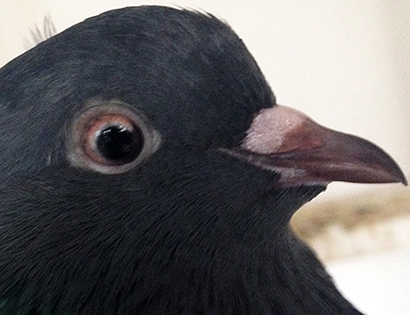 In addition to either getting either a full bull eye or either orange
or pearl eye, pigeons sometimes can get a cracked eye, where the migration
works for parts of the iris but not for another parts. A cracked eye
can simply be the dividing line between where pigment cells migrated
and where they did not migrate if it is a case of partly bull vs partly
orange or pearl. If it is partly orange and partly pearl it is probably
either a somatic mutation or a chimera. However, I have never seen
or heard such cracked eye. We do not yet understand what causes
cracked
eyes in pigeons; however, it seems that perhaps the pigment cell migration
is slightly different between those going to the eyes and those going
to the feathers since we even don’t know for sure that the pigment
cells that go to the eye are identical to those that go to the feathers.
This can explain why we get odd eyes (one bull and one normal) even on
perfectly white headed birds where we would expect both eyes to be bull
eyes if the surrounding feathers of the eyes are white. The migration
of the cells being different that goes to the eye and those going to
feathers theory can also explain the cracked eye phenomenon in pigeons.
In addition to either getting either a full bull eye or either orange
or pearl eye, pigeons sometimes can get a cracked eye, where the migration
works for parts of the iris but not for another parts. A cracked eye
can simply be the dividing line between where pigment cells migrated
and where they did not migrate if it is a case of partly bull vs partly
orange or pearl. If it is partly orange and partly pearl it is probably
either a somatic mutation or a chimera. However, I have never seen
or heard such cracked eye. We do not yet understand what causes
cracked
eyes in pigeons; however, it seems that perhaps the pigment cell migration
is slightly different between those going to the eyes and those going
to the feathers since we even don’t know for sure that the pigment
cells that go to the eye are identical to those that go to the feathers.
This can explain why we get odd eyes (one bull and one normal) even on
perfectly white headed birds where we would expect both eyes to be bull
eyes if the surrounding feathers of the eyes are white. The migration
of the cells being different that goes to the eye and those going to
feathers theory can also explain the cracked eye phenomenon in pigeons.
Although cracked eyes very common in most breeds, in my experience all my cracked eyed pigeons are my pencil Rollers. How does a pencil bird that has fully pigmented head feathers end up getting partially bull eyes is a mystery. Thus, either the cell migration is not the only explanation/cause of bull/cracked eyes or the cell migration to the eyes follow a different path than those migrate to the feathers. This could also explain why ice birds have bull eyes. Perhaps ice mutant somehow allows cell migration to everywhere except the eyes.
False Pearl Eyes:
According to Joe Quinn brown pigeons seldom have orange eyes because the brown mutation affects certain aspect of iris pigmentation producing a creamy white “pearl-eye” like coloration and it is known as the “false pearl” eyes. According to Dr. Cryberg the usual function of the wild-type at brown gene is to make an enzyme that allows oxidation of a particular compound that makes black pigment when oxidized. In the case of brown mutation however, this gene that makes the black pigment (wild-type) is mutated and oxidation does not happen and therefore producing brown pigment instead of black. When we have a normal bird with a mutation that shuts down production of the pteridine (orange) pigment in the iris we get a pearl eye. A pearl eyed bird just have guanidine and perhaps traces of melanin plus the blood vessels. In the case of false pearl eyes, presumably the chemical that is needed to turn brown pigment into black pigment is also needed for some important step in the manufacture of pteridine (orange) pigments. So a brown bird is unable to make pteridines and therefore presenting itself as false pearl eyes.
“In pigeon eyes there are two non melanin pigments. One is called a guanidine and the other a pteridine. The guanidine makes a whitish opaque pigment while the pteridine makes an orange pigment. Apparently the chemical produced by wild-type at brown is not only important in allowing production of black pigment in feathers but also important in making orange pteridine in the eyes. There is a protein that is essential to make black pigment named Tyrosinase Related Protein. The wild-type gene that makes this protein is symbolized Trp1. When this protein is defective it does not function and instead of making black pigment, pigeons make brown pigment. When a pigeon is homozygous for this defective form of Trp1 that does not work the pteridine synthesis in the eye nearly fails 100%. So, it seems normal Trp1 is required to make orange pteridine. The lack of very much pteridine in a brown pigeon is why brown pigeons have false pearl eyes. The reason is brown pigeons do not seem to make any pteridine and as a result have false pearl eyes,” says Dr. Richard Cryberg.
Pink Eye Dilute:
We don’t really understand the exact biochemistry which causes pink eye dilute on wild-type. The only sure thing we know is that it is not albino. We know that by definition the albino gene is the gene that makes a melanin called tyrosinase. From the human studies, we also know that several gens can present themselves as near albino in their phenotype. So, far the best guess we can come up with to explain pink eye dilute in pigeons is much the same as we see in human examples. It is a mystery that this gene only causes the eye color to turn into pink instead of effecting rest of the body like the albino mutation does. We know that any time two normal intensity birds produce a dilute, that dilute bird will be a hen and short downed. However in the rare exception of pink eyed dilute that is autosomal and recessive, we can produce cock birds from two normal intensity birds. Even though pink eye dilute is not very common in most breeds, in homozygous state this gene causes poor eyesight and the adults have pink eyes.
Other Eye Colors:
Orange, Pearl, Bull and Pink eyes we can explain…but what about the green violet or dark brown eyes? No doubt, new mutations happen all the time and the science has not explained or not enough research has been done on other eye colors yet. These additional iris pigments could be the new alleles to yellow and pearl eyes or could even be the allele of the bull eyes that simply modifies them.
Genetic explanation of the eye pigments and possible results
Is the Orange or the Pearl eye dominant to Bull eye? First of all, bull eye is not actually a color but instead is expressed when melanin is missing or not produced on the outside of the iris. The Bull eye is not even an allele of orange or white eyes and therefore, we can't compare them. Remember that we can only compare mutations that are alleles. In addition, every bull eyed pigeon still carries two additional alleles for eye color, which we cannot determine until we mate the bird number of times and look at the eye color results of the offspring. When we mate an Orange eye or Pearl eye to a Bull eye bird, depending on the pigment production of the offspring's eyes, we can get bull eyed off spring, orange or pearl eye offspring, or split eye (one of the eyes is bull, the other showing a color). Bull eyes are pigmented eye colors but rather the result of the same modifier that produces white feathers in piebald whites or splashed birds. So the answer to the question is that we cannot determine or compare the dominance of the Orange or Pearl eyes to Bull eyes.
I will assume mutations like pink eye dilute, albinism, or bull eye are not present in the genotype of the following mating scenarios.
Homozygous Orange Eye (+//+) - Both eye color pigment alleles are orange. This bird has no choice but to donate one of the orange pigment alleles during mating. This also means that whichever eye color we mate this bird, the eye color of all the offspring will be orange eyes.
Homozygous Orange Eye x Homozygous
Orange Eye - 100% the offspring will be
homozygous orange eyes.
Homozygous Orange Eye x Heterozygous
Orange Eye Carrying Pearl (+//tr)
- All the offspring will have orange eyes. 50% of the offspring
will
have
homozygous orange eyes and 50% of the offspring will have heterozygous
orange
eyes carrying pearl.
Heterozygous Orange Eye (+//tr) - This bird is expressing (showing) orange eyes but carrying pearl eyes. Therefore, this bird is carrying 2 different alleles (heterozygous) for the eye color. It will be showing orange eyes instead of pearl eyes in its phenotype because pearl is recessive to orange (wild-type) eyes.
Heterozygous Orange Eye x Homozygous
Orange Eye - All the offspring will have
orange eyes from this mating. 50% will be homozygous orange eyes. 50%
will be heterozygous orange eye carrying pearl.
Heterozygous Orange Eye x Heterozygous
Orange Eye - From this mating
25% of the offspring will be homozygous orange eyes. 50% will be
heterozygous orange eyes carrying pearl eyes. 25% will be homozygous
pearl eyes.
Homozygous Pearl Eye (tr//tr) - Both eye color pigment alleles are Pearl. Pearl eyes are expressed only in homozygous state. This bird has no choice but to donate one of the Pearl eye allele during mating.
Homozygous Pearl Eye x Homozygous
Orange Eye - All the offspring will be
orange eyes. 100 % of the offsprig will be Heterozygous Orange eyes
carrying Pearl eyes.
Homozygous Pearl Eye x Heterozygous
Orange Eye Carrying Pearl - 50% of the
offspring will be Heterozygous Orange eyes carrying Pearl and 50% of
the offspring will be Homozygous Pearl Eyes.
Heterozygous Pearl Eye - No such thing, as pearl eyes can only be expressed in Homozygous state.
Before
I started to write about pigeon genetics I paid no attention to the
eye color of the pigeons. I keep performing breeds like tumblers
and
rollers and eye color is the last thing I would have looked for in
performing breeds. Same
goes with the color and the pattern of the bird, where performance
is 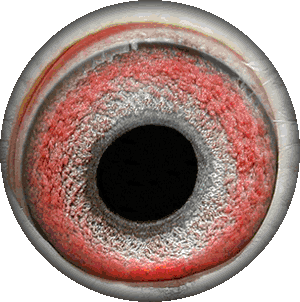 number one priority in my pigeons and
color comes second. I understand why an eye color for a show pigeon
would be very important as the judge gives points to eye color of
the bird. However, why the eye color is also important for breeders
of homers, tipplers, rollers and tumblers? Why do some people think
the eye color has a correlation between intelligence and the performance
of the bird? The fact is there isn't enough scientific research conducted
on "Eye Sign" in pigeons and there is no scientific evidence
suggesting the eye sign will affect the performance or the intelligence
of pigeons.
number one priority in my pigeons and
color comes second. I understand why an eye color for a show pigeon
would be very important as the judge gives points to eye color of
the bird. However, why the eye color is also important for breeders
of homers, tipplers, rollers and tumblers? Why do some people think
the eye color has a correlation between intelligence and the performance
of the bird? The fact is there isn't enough scientific research conducted
on "Eye Sign" in pigeons and there is no scientific evidence
suggesting the eye sign will affect the performance or the intelligence
of pigeons.
Most breeders, especially eastern European and Middle Eastern breeders, like to see pearl eyes, white beaks and light colors in their breeds. Even though most breeders would agree that in performing breeds the performance and intelligence comes first. In some regions however, it would be unacceptable for performing birds to be mismarked and they are culled based on their looks. They are considered to be feral or worthless if they happened to have orange eyes like the wild-type. Some tippler breeders prefer pearl eyes, as they believe the pearl eye birds are smarter and more intelligent than the rest. The judge who is scoring Birmingham Rollers can only give points for how fast, how long, and how frequent a roller kit rolls during a competition. Not only there are no points given to color of the birds, but it would be pretty darn hard to see the eye and the beak color of the birds while they are in flight spinning at an inestimable speed. A lot of racing homer breeders would not breed pearl eye to pearl eye, as they think it would weaken the eye of the bird and therefore the performance of the bird. There is no scientific research or evidence suggesting that however, that the pearl eye colored pigeons cannot perform as well as the other eye colors. The only thing a racing homer breeder should care about is how fast a bird comes home and traps itself. Eye sign study in racing pigeons is at the best of times a confusing and is at the very least, a subject which has sparked more argument and difference of opinion than any other subject related to the racing of pigeons.
Yet, there are books written
about the eye colors and videos made suggesting “eye sign” and performance are
correlated. Many theories and versions continually circle this subject, so much so that it is nearly impossible to know what to believe and whom to believe. There are some pigeon racers who totally dismiss the eye concept as being a basis for determining a pigeon's ability as a racer, breeder or even both.
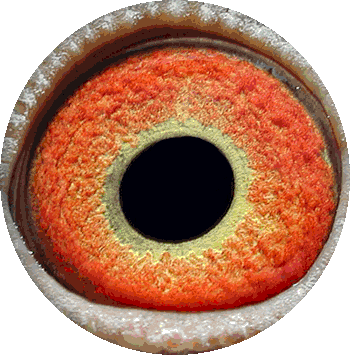 Scientifically
speaking, feather color, eye color, beak color, intelligence and
performance are all different traits of the genes that each pigeon
carries and therefore they cannot be correlated with each other. It
is
like saying people with brown eyes are smarter than others, or people
with
light skin color can jump higher or longer. People with red hair cannot
tolerate sun and heat like other people but they are better in winter
sports! How ignorant did that sound like?
Scientifically
speaking, feather color, eye color, beak color, intelligence and
performance are all different traits of the genes that each pigeon
carries and therefore they cannot be correlated with each other. It
is
like saying people with brown eyes are smarter than others, or people
with
light skin color can jump higher or longer. People with red hair cannot
tolerate sun and heat like other people but they are better in winter
sports! How ignorant did that sound like?
Athletic ability comes from the personal determination, physical type of the body, many hours of practice and training, and the diet in humans just like the performing breeds in pigeons. Intelligence is a trait we get from both of our parents and it has nothing to do with our physical appearance and the same goes for the pigeons. It is therefore a big misconception to draw a conclusion based on the color of the feathers, eyes, or the beak with the performance and the intelligence of the pigeons. If it was that simple, we would only have one eye color, one feather color and one pigeon pattern in all performing breeds, if performance was based on the color. I might be upsetting a lot of people here, but I don’t believe in theories. Unless someone actually scientifically proves this, I suggest we all use a common sense and let’s judge the bird by its performance not by its color and patterns.
It would be great if all of the pigeons have exceptional colors and markings and have the performance in the same time. However, let's not forget that color and performance are two different traits and they are inherited independently from each other.
I breed performing pigeons and I have a goal. My goal is to breed the best performing birds with exceptional physical appearance -- feather colors and markings, beak and eye colors. I would reach my ultimate goal when I breed birds that have show type quality and a top performance at the same time. In this page my goal was to simply explain the genetics of the eyes which was solved many years ago, although there are still some unanswered questions.